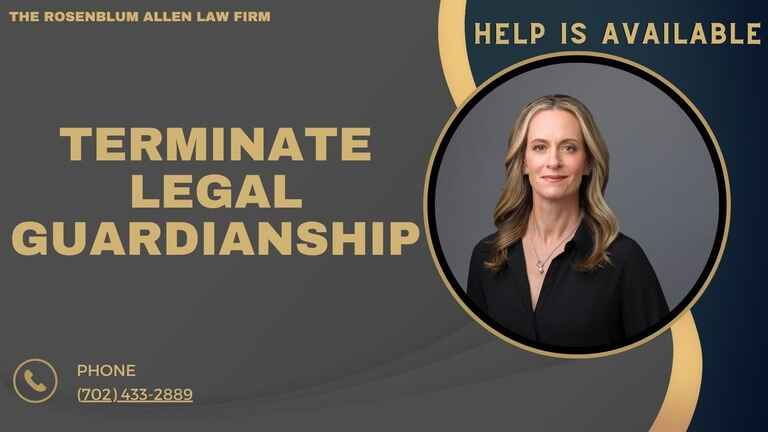Terminate Legal Guardianship: A Complete Guide
Legal guardianship is a court-appointed role where an individual or entity is given the responsibility to care for a minor or an incapacitated person. Guardians are typically responsible for the physical, emotional, and financial well-being of the person under their care, often stepping in when biological parents are unable to do so.
But what happens when the need for guardianship ends? Maybe a biological parent is now ready to take over, or the guardian is no longer able to fulfill their duties. The process to end legal guardianship is one that requires careful attention to detail and a clear understanding of the legal framework.
This guide explains the reasons, legal grounds, and steps involved in ending legal guardianship.

Legal Grounds for Terminating Legal Guardianship
There are two primary ways that legal guardianship can be terminated: voluntarily or involuntarily. Each has its own process and legal requirements.
Voluntary Termination
A guardian or the person under guardianship can request to voluntarily end the legal relationship. Common reasons include:
- The child has turned 18 and is no longer a minor.
- The biological parents are now able to resume care of the child.
- The guardian is no longer able to fulfill their responsibilities, due to health issues or personal circumstances.
Involuntary Termination
In some cases, guardianship is terminated against the will of the guardian. This happens if:
- The court determines that the guardian is no longer suitable to care for the child or ward.
- The guardian has failed in their duties, such as neglecting the person under their care or mismanaging finances.
- The welfare of the person under guardianship is at risk, prompting a court decision to remove the guardian.
Process to Terminate Legal Guardianship
Ending legal guardianship requires a formal process, typically involving the court system. The steps can vary depending on the state and individual case, but the general process follows a structured path.
Filing a Petition
The first step is to file a petition to terminate the guardianship. The petitioner can be the current guardian, a biological parent, or another concerned party.
Where to File the Petition
The petition must be filed in the same court that originally granted the guardianship. This is usually a family or probate court.
Required Forms and Documentation
When filing the petition, certain forms and documents are required, such as:
- The original court order establishing the guardianship
- A written explanation outlining the reason for termination
- Proof of any changes in circumstances, such as the biological parent’s ability to care for the child
Notice Requirements
Once the petition is filed, certain parties must be notified of the hearing.
Who Must Be Notified
- The biological parents (if they were not the ones filing)
- The child, if they are old enough to understand the situation
- Any other interested parties, such as relatives or the current guardian
How to Properly Serve Notice
Notices must be served following legal procedures. This may include certified mail or hand delivery by a court-approved process server. The court may require proof that all parties have been notified, such as a return receipt or affidavit of service.
Court Hearing
Once the petition and notice requirements are completed, a court hearing will be scheduled. This is the most crucial part of the process.
Preparing for the Hearing
The petitioner should gather all evidence that supports their request for termination. This could include:
- Statements from the biological parents proving their readiness to resume care
- Medical or financial reports showing why the guardian can no longer serve
- Testimonies from other parties who support the termination
What to Expect at the Hearing
During the hearing, the judge will review the petition, hear from the involved parties, and evaluate evidence. In some cases, the judge may interview the child, depending on their age and maturity, to understand their wishes.
Factors the Court Considers
When deciding whether to terminate a legal guardianship, the court carefully looks at multiple factors. The main focus is ensuring the safety and well-being of the child or the person under guardianship. Each case is different, but these are the most common elements the court reviews.
Best Interests of the Child
The court’s priority is always the best interests of the child. A few things play into this:
Stability and Safety: The court will look at whether terminating the guardianship would disrupt the child’s living situation. Are they moving into a safe and stable environment?
Emotional Bonds: Strong emotional ties between the child and their guardian can impact the decision. The court will not want to harm these bonds unless there is a valid reason to terminate the guardianship.
The Child’s Wishes: If the child is old enough to understand what’s happening, the court might ask for their opinion. This is usually the case with teenagers or mature minors. Though their opinion is taken into account, it isn’t the only factor in the decision.
Guardian’s Ability to Provide Care
If the guardianship is ending involuntarily, the court will examine whether the guardian can still provide care.
Health and Well-being of the Guardian: If the guardian is unable to care for the child due to health issues, this could be a reason for termination.
Financial Stability: The court will also review the guardian’s financial situation. Are they still able to support the child or ward?
Biological Parents’ Rights and Intentions
The biological parents’ situation often plays a big role when they are seeking to regain custody.
Parental Rights: If the parents are now able to take care of the child, the court may restore their parental rights. They need to show they can provide a safe and stable environment for their child.
Intentions and Plan: The court will also look at the biological parents’ intentions. Are they serious about resuming their parental role, or is this a temporary request?

After Termination: What Happens Next?
Terminating a legal guardianship doesn’t end the court’s involvement. It’s just the start of the next chapter. There are a few different outcomes depending on the circumstances.
Reinstatement of Parental Rights
If the biological parents were the ones filing the petition, their parental rights may be restored.
- Conditions for Reinstatement: The court will only reinstate parental rights if it believes the parents are fit to take care of the child. This might require proving changes in circumstances, such as stable housing or a steady income.
Appointment of a New Guardian
In some cases, a new guardian will be appointed after the termination.
- Steps if a New Guardian is Needed: If neither the biological parents nor the current guardian can care for the child, the court will appoint someone else. This could be a relative or, in some situations, a state-appointed guardian.
Child’s Placement in Foster Care
If no suitable guardian is available, the court may place the child in foster care.
- Temporary or Permanent Care: Foster care can either be temporary, while a new guardian is found, or it may be a long-term solution, depending on the situation.

Breaking It Down
Terminating a legal guardianship can be a complex process, but understanding the steps involved makes it more manageable. Each case is unique, so it’s important to prioritize the best interests of the child at every stage.
Whether you are a guardian, a biological parent, or another party involved, having the right information and support can help navigate this journey. Legal advice can prove invaluable, guiding you through the petition process and potential court hearings.
In the end, the goal is to ensure that the child’s needs are met and that they are placed in a safe and loving environment. If you’re contemplating this decision, take the time to evaluate your options carefully. The future of the child or ward is paramount, and every effort should be made to protect their well-being.

Frequently Asked Questions
What is legal guardianship, and how does it differ from adoption?
Legal guardianship is a legal relationship where one person (the guardian) is given the authority to care for another person (the ward) who is often a minor. Unlike adoption, guardianship does not permanently sever the legal rights of the biological parents. Guardianship can be temporary or permanent, whereas adoption is a permanent arrangement.
Can a guardian terminate their own guardianship?
Yes, a guardian can file a petition to terminate their own guardianship if they believe it is no longer necessary or in the best interest of the ward. However, the court will review the situation before making a decision.
What grounds can be used to terminate a legal guardianship?
Common grounds for terminating a legal guardianship include:
- Changes in circumstances, such as the biological parent’s ability to care for the child.
- The ward reaching adulthood or becoming self-sufficient.
- The guardian’s inability to fulfill their responsibilities.
What happens if a guardian wants to terminate guardianship but the ward does not agree?
The court will ultimately make the decision based on what is in the best interest of the child. If the ward is old enough, their wishes may be considered, but the court will assess the overall situation.
Is there a specific age when a child can request to terminate their guardianship?
The age at which a child can request to terminate guardianship varies by state. In many jurisdictions, once the child reaches the age of 14 or 15, they may have the right to express their wishes in court.
How long does the process of terminating guardianship typically take?
The duration of the termination process can vary based on several factors, including court schedules and the complexity of the case. Generally, it can take several weeks to a few months.
What are the potential costs associated with terminating guardianship?
Costs can include filing fees, attorney fees, and any other associated legal expenses. The total amount will depend on your specific situation and whether you choose to hire legal counsel.
Can a terminated guardianship be reinstated?
In some cases, if the conditions that led to the guardianship termination change, it may be possible to establish a new guardianship. This would require filing a new petition with the court.
What support resources are available for those going through the termination process?
Various resources are available, including legal aid organizations, family support services, and community organizations that specialize in family law. These resources can provide guidance and support throughout the process.

Glossary
Adoption: A legal process in which a person or couple becomes the legal parents of a child, permanently severing the biological parents’ rights.
Biological Parent: The person or persons who are the natural parents of a child, typically having legal rights and responsibilities toward that child.
Child Welfare: A system that ensures the well-being of children, focusing on their safety, health, and overall development.
Court Hearing: A formal session in which a judge reviews evidence and arguments presented by parties involved in a legal matter.
Guardian: An individual who is legally appointed to care for another person (the ward) and make decisions on their behalf.
Guardianship: A legal relationship in which one person (the guardian) is given the authority to care for another person (the ward), often a minor.
Petition: A formal written request submitted to the court, seeking a specific legal action or decision.
Ward: A person, often a minor, who is under the protection and care of a guardian due to various circumstances, such as the inability of biological parents to provide care.
Termination of Guardianship: The legal process of ending a guardianship arrangement, which can occur for various reasons, including changes in circumstances or the ward reaching adulthood.
Best Interests of the Child: A legal standard used to determine what is most beneficial for a child’s welfare, safety, and overall well-being.
Foster Care: A temporary arrangement in which a child is placed in the care of a family or individual who is not their biological parent, typically due to the parents’ inability to provide care.
Legal Rights: The entitlements and protections granted to individuals under the law, which can include the right to make decisions about a child’s upbringing.
Custody: The legal right to make decisions about a child’s welfare and where they will live.

Additional Resources for You from The Rosenblum Allen Law Firm
As you navigate the complexities of legal guardianship and related issues, we want to remind you that our lead attorney, Molly Rosenblum Allen, Esq., has created a variety of resources to assist you during this challenging time. Here are some valuable links that may help you further:
Dependency Cases: Explore information about dependency cases and the support available for families in need.
Terminate Legal Guardianship: Learn about the process and implications of terminating a legal guardianship.
Parental Responsibility for Disabled Adults: Understand the legal responsibilities parents have toward their disabled adult children.
Nevada Power of Attorney: Gain insights into the power of attorney in Nevada and how it can impact your legal rights.
We encourage you to explore these resources to gain a better understanding of your rights and options. If you need personalized legal assistance, don’t hesitate to reach out to us. We’re here to help.

Offsite Resources for You
Here are some different articles related to legal guardianship and family law, with both the article titles and website names included in the anchor text:
Guardianship Basics – Nolo: This article outlines the fundamental concepts of guardianship, including the roles and responsibilities of a guardian.
What is Guardianship? – FindLaw: This resource provides a clear definition of guardianship and explains the different types available.
Understanding Legal Guardianship and the Rights of Guardians – American Bar Association: This article covers the legal rights of guardians and the responsibilities that come with guardianship.
Planning for Guardianship: The Importance of Legal Documentation – AARP: This article discusses the importance of legal documentation when planning for guardianship, particularly for aging individuals and their families.

A Special Message from Our Lead Attorney, Molly Rosenblum Allen, Esq

Thank you for taking the time to explore our resources on legal guardianship and related topics. I hope you found the information helpful and informative during this important time.
If you have any questions or need further assistance, I invite you to schedule a free consultation with our team. We are here to help guide you through your legal journey. You can reach us by calling (702) 433-2889.
Wishing you all the best,
Molly Rosenblum Allen, Esq.
The Rosenblum Allen Law Firm



